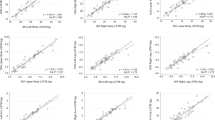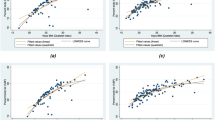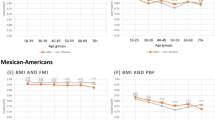Abstract
Background/Objectives
Bioelectrical impedance is one of the most used clinical techniques to assess body composition; however, it is necessary that the available predictive equations are valid for the evaluated subjects. This study aimed to develop and cross-validate equations for fat-free mass (FFM) and lean soft tissue mass (LSTM) by bioelectrical impedance for Brazilian women, in addition to test the validity of other available equations.
Subjects/Methods
Cross-sectional study with 222 women aged 20–59 years, randomly divided into two groups: development and cross-validation. The standard technique for assessing fat mass, FFM and LSTM was dual energy X-ray absorptiometry. Paired t test, multiple regression, and Bland–Altman plots were used to test the validity of the proposed models, as well as to perform cross-validation of the models.
Results
The equations derived in this study were: FFM = 16.284 + 0.442 × (Height2/Resistance) − 0.13 × age + 0.302 × Weight − 0.121 × Waist Circumference; r2 = 0.86; SEE = 2.32 kg; and LSTM = 14.732 + 0.427 × (Height2/Resistance) − 0.125 × age + 0.291 × Weight − 0.115 × Waist Circumference; r2 = 0.92; SEE = 2.29 kg. In addition, the new equation for FFM showed better agreement when compared to another equation developed for a Brazilian population.
Conclusions
The newly developed equations provide a valid FFM and LSTM estimation and are recommended for Brazilian women with similar characteristics.
This is a preview of subscription content, access via your institution
Access options
Subscribe to this journal
Receive 12 print issues and online access
$259.00 per year
only $21.58 per issue
Buy this article
- Purchase on Springer Link
- Instant access to full article PDF
Prices may be subject to local taxes which are calculated during checkout


Similar content being viewed by others
References
Becroft L, Ooi G, Forsyth A, King S, Tierney A. Validity of multi-frequency bioelectric impedance methods to measure body composition in obese patients: a systematic review. Int J Obes. 2019;43:1497–507. https://doi.org/10.1038/s41366-018-0285-9. e-pub ahead of print 2018/12/21.
Kushner RF, Schoeller DA. Estimation of total body water by bioelectrical impedance analysis. Am J Clin Nutr. 1986;44:417–24.
Lemos T, Gallagher D. Current body composition measurement techniques. Curr Opin Endocrinol Diabetes Obes. 2017;24:310–4. https://doi.org/10.1097/MED.0000000000000360.
Lohman TG. Applicability of body composition techniques and constants for children and youths. Exerc sport Sci Rev. 1986;14:325–57.
Sun SS, Chumlea WC, Heymsfield SB, Lukaski HC, Schoeller D, Friedl K, et al. Development of bioelectrical impedance analysis prediction equations for body composition with the use of a multicomponent model for use in epidemiologic surveys. Am J Clin Nutr. 2003;77:331–40. https://doi.org/10.1093/ajcn/77.2.331.
Gonzalez MC, Orlandi SP, Santos LP, Barros AJ. Body composition using bioelectrical impedance: development and validation of a predictive equation for fat-free mass in a middle-income country. Clin Nutr. 2019;38:2175–9.
Wang L, Hui SS-C, Wong SH-S. Validity of bioelectrical impedance measurement in predicting fat-free mass of Chinese children and adolescents. Med Sci Monit: Int Med J Exp Clin Res. 2014;20:2298.
Langer RD, Borges JH, Pascoa MA, Cirolini VX, Guerra-Junior G, Goncalves EM. Validity of bioelectrical impedance analysis to estimation fat-free mass in the army cadets. Nutrients. 2016;8:121. https://doi.org/10.3390/nu8030121.
Beaudart C, Bruyère O, Geerinck A, Hajaoui M, Scafoglieri A, Perkisas S, et al. Equation models developed with bioelectric impedance analysis tools to assess muscle mass: a systematic review. Clin Nutr ESPEN. 2020;35:47–62.
Dehghan M, Merchant AT. Is bioelectrical impedance accurate for use in large epidemiological studies?. Nutr J. 2008;7:26. https://doi.org/10.1186/1475-2891-7-26.
Kyle UG, Bosaeus I, De Lorenzo AD, Deurenberg P, Elia M, Gomez JM, et al. Bioelectrical impedance analysis–part I: review of principles and methods. Clin Nutr. 2004;23:1226–43. https://doi.org/10.1016/j.clnu.2004.06.004.
Jayawardena R, Wijetunga W, Ranasinghe P, Wanninayake L, Wickramasinghe VP. Assessment of body composition in Sri Lankan adults: development and validation of bioelectrical impedance prediction equation. Eur J Clin Nutr. 2019. https://doi.org/10.1038/s41430-019-0521-y. e-pub ahead of print 2019/11/02.
Aglago KE, Menchawy IE, Kari KE, Hamdouchi AE, Barkat A, Bengueddour R, et al. Development and validation of bioelectrical impedance analysis equations for predicting total body water and fat-free mass in North-African adults. Eur J Clin Nutr. 2013;67:1081–6. https://doi.org/10.1038/ejcn.2013.125.
Hastuti J, Kagawa M, Byrne NM, Hills AP. Proposal of new body composition prediction equations from bioelectrical impedance for Indonesian men. Eur J Clin Nutr. 2016;70:1271–7. https://doi.org/10.1038/ejcn.2016.113.
Hughes JT, Maple-Brown LJ, Piers LS, Meerkin J, O’Dea K, Ward LC. Development of a single-frequency bioimpedance prediction equation for fat-free mass in an adult Indigenous Australian population. Eur J Clin Nutr. 2015;69:28–33. https://doi.org/10.1038/ejcn.2014.54. e-pub ahead of print 2014/04/24.
Hofsteenge GH, Chinapaw MJ, Weijs PJ. Fat-free mass prediction equations for bioelectric impedance analysis compared to dual energy X-ray absorptiometry in obese adolescents: a validation study. BMC Pediatri. 2015;15:158. https://doi.org/10.1186/s12887-015-0476-7.
Lohman TG, Roche AF, Martorell R Anthropometric standardization reference manual, vol. 177. Champaign: Human kinetics books; 1988.
Costa RF, Masset KB, Sousa EC, Cabral BT, Dantas PS. Development and cross-validation of predictive equations of fat-free mass by bioelectrical impedance for Brazilian men aged 20 to 59 years old. Motricidade. 2018;14:26–32.
Nana A, Slater GJ, Stewart AD, Burke LM. Methodology review: using dual-energy X-ray absorptiometry (DXA) for the assessment of body composition in athletes and active people. Int J sport Nutr Exerc Metab. 2015;25:198–215.
Guo S, Chumlea WC. Statistical methods for the development and testing of predictive equations. Hum body composition. 1996;10:191–202.
Ndagire CT, Muyonga JH, Odur B, Nakimbugwe D. Prediction equations for body composition of children and adolescents aged 8–19 years in Uganda using deuterium dilution as the reference technique. Clin Nutr ESPEN. 2018;28:103–9. https://doi.org/10.1016/j.clnesp.2018.09.004. e-pub ahead of print 2018/11/06.
Lin LI. A concordance correlation coefficient to evaluate reproducibility. Biometrics. 1989;45:255–68. e-pub ahead of print 1989/03/01.
Kyle UG, Genton L, Karsegard L, Slosman DO, Pichard C. Single prediction equation for bioelectrical impedance analysis in adults aged 20–94 years. Nutrition. 2001;17:248–53.
Rech CR, Cordeiro BA, Petroski EL, Vasconcelos FA. Validation of bioelectrical impedance for the prediction of fat-free mass in Brazilian elderly subjects. Arq Bras Endocrinol Metabol. 2008;52:1163–71.
Houtkooper LB, Lohman TG, Going SB, Howell WH. Why bioelectrical impedance analysis should be used for estimating adiposity. Am J Clin Nutr. 1996;64:436S–448S. https://doi.org/10.1093/ajcn/64.3.436S.
Khalil SF, Mohktar MS, Ibrahim F. The theory and fundamentals of bioimpedance analysis in clinical status monitoring and diagnosis of diseases. Sensors. 2014;14:10895–928. https://doi.org/10.3390/s140610895. e-pub ahead of print 2014/06/21.
Wang Z, Deurenberg P, Wang W, Pietrobelli A, Baumgartner RN, Heymsfield SB. Hydration of fat-free body mass: new physiological modeling approach. Am J Physiol-Endocrinol Metab. 1999;276:E995–1003.
Aleman-Mateo H, Rush E, Esparza-Romero J, Ferriolli E, Ramirez-Zea M, Bour A, et al. Prediction of fat-free mass by bioelectrical impedance analysis in older adults from developing countries: a cross-validation study using the deuterium dilution method. J Nutr Health Aging. 2010;14:418–26.
Dioum A, Gartner A, Cissé AS, Delpeuch F, Maire B, Wade S, et al. Validity of impedance-based equations for the prediction of total body water as measured by deuterium dilution in African women. Am J Clin Nutr. 2005;81:597–604.
Sergi G, De Rui M, Stubbs B, Veronese N, Manzato E. Measurement of lean body mass using bioelectrical impedance analysis: a consideration of the pros and cons. Aging Clin Exp Res. 2017;29:591–7.
Stevens J, Truesdale KP, Cai J, Ou FS, Reynolds KR, Heymsfield SB. Nationally representative equations that include resistance and reactance for the prediction of percent body fat in Americans. Int J Obes. 2017;41:1669–75. https://doi.org/10.1038/ijo.2017.167. e-pub ahead of print 2017/07/25.
Swainson MG, Batterham AM, Tsakirides C, Rutherford ZH, Hind K. Prediction of whole-body fat percentage and visceral adipose tissue mass from five anthropometric variables. PloS ONE. 2017;12:e0177175. https://doi.org/10.1371/journal.pone.0177175. e-pub ahead of print 2017/05/12.
de Carvalho ABR, Neto CSP. Desenvolvimento e validação de equações para estimativa da massa corporal magra através da impedância bioelétrica em mulheres. Rev Brasileira Ativ FíSci Saúde. 1998;3:14–21.
Demura S, Yamaji S, Kitabayashi T. Residual volume on land and when immersed in water: effect on percent body fat. J Sports Sci. 2006;24:825–33. https://doi.org/10.1080/02640410500128163.
Kotler DP, Burastero S, Wang J, Pierson RN Jr. Prediction of body cell mass, fat-free mass, and total body water with bioelectrical impedance analysis: effects of race, sex, and disease. Am J Clin Nutr. 1996;64:489S–97S.
Marra M, Sammarco R, De Lorenzo A, Iellamo F, Siervo M, Pietrobelli A, et al. Assessment of body composition in health and disease using bioelectrical impedance analysis (BIA) and dual energy x-ray absorptiometry (DXA): a critical overview. Contrast Media Mol Imaging. 2019;2019:3548284. https://doi.org/10.1155/2019/3548284. e-pub ahead of print 2019/07/06.
Gagnon C, Menard J, Bourbonnais A, Ardilouze J-L, Baillargeon J-P, Carpentier AC, et al. Comparison of foot-to-foot and hand-to-foot bioelectrical impedance methods in a population with a wide range of body mass indices. Metab Syndr Relat Disord. 2010;8:437–41.
Guedes DP, Calabrese JC, Pirolli PM. Use of different segmental multi-frequency bioelectrical impedance devices for analysis of body composition in young adults: comparison with bioelectrical spectroscopy. Nutricion hospitalaria. 2019;36:618–25. https://doi.org/10.20960/nh.2376. e-pub ahead of print 2019/06/14.
Silva AM, Matias CN, Nunes CL, Santos DA, Marini E, Lukaski HC, et al. Lack of agreement of in vivo raw bioimpedance measurements obtained from two single and multi-frequency bioelectrical impedance devices. Eur J Clin Nutr. 2019;73:1077–83. https://doi.org/10.1038/s41430-018-0355-z. e-pub ahead of print 2018/10/24.
Pace N, Rathbun EN. Studies on body composition. 3. The body water and chemically combined nitrogen content in relation to fat content. J Biol Chem. 1945;158:685–91.
Silva AM, Wang J, Pierson RN Jr, Wang Z, Heymsfield SB, Sardinha LB, et al. Extracellular water: greater expansion with age in African Americans. J Appl Physiol. 2005;99:261–7.
Wells JC, Williams JE, Chomtho S, Darch T, Grijalva-Eternod C, Kennedy K, et al. Pediatric reference data for lean tissue properties: density and hydration from age 5 to 20 y. Am J Clin Nutr. 2010;91:610–8.
Rush EC, Puniani K, Valencia ME, Davies PS, Plank LD. Estimation of body fatness from body mass index and bioelectrical impedance: comparison of New Zealand European, Maori and Pacific Island children. Eur J Clin Nutr. 2003;57:1394–401. https://doi.org/10.1038/sj.ejcn.1601701. e-pub ahead of print 2003/10/25.
Minderico CS, Silva AM, Keller K, Branco TL, Martins SS, Palmeira AL, et al. Usefulness of different techniques for measuring body composition changes during weight loss in overweight and obese women. Br J Nutr. 2008;99:432–41.
Sluyter JD, Schaaf D, Scragg RK, Plank LD. Prediction of fatness by standing 8‐electrode bioimpedance: a multiethnic adolescent population. Obesity. 2010;18:183–9.
Mason J, Morris C, Long DE, Sanden MN, Flack K. Comparison of body composition estimates among norland elite®, lunar iDXA®, and the bodPod® in overweight to obese adults. Meas Phys Educ Exerc Sci. 2020;24:65–73.
Sakai Y, Ito H, Meno T, Numata M, Jingu S. Comparison of body composition measurements obtained by two fan-beam DXA instruments. J Clin Densitom. 2006;9:191–7. https://doi.org/10.1016/j.jocd.2006.03.008.
Heyward VH, Wagner DR. Applied body composition assessment. Champaigne, IL: Human Kinetics; 2004.
Bosy-Westphal A, Jensen B, Braun W, Pourhassan M, Gallagher D, Müller MJ. Quantification of whole-body and segmental skeletal muscle mass using phase-sensitive 8-electrode medical bioelectrical impedance devices. Eur J Clin Nutr. 2017;71:1061–7. https://doi.org/10.1038/ejcn.2017.27.
Heymsfield SB, Ebbeling CB, Zheng J, Pietrobelli A, Strauss BJ, Silva AM, et al. Multi‐component molecular‐level body composition reference methods: evolving concepts and future directions. Obes Rev. 2015;16:282–94.
Acknowledgements
The authors would like to thank all volunteers who participated in this study and all students and research assistants who made it possible to complete the study.
Funding
This study was financed in part by the Coordenação de Aperfeiçoamento de Pessoal de Nível Superior—Brasil (CAPES)—Finance Code 001.
Author information
Authors and Affiliations
Contributions
RFC devised the conceptual idea and study design. RFC and KVSBM were involved in data collection. RFC, AMS, and KVSBM were involved in statistical analysis and drafting the paper. All authors provided critical feedback on the paper. AMS BGATC, and PMSD revised the paper. All authors read and approved the final paper.
Corresponding author
Ethics declarations
Conflict of interest
The authors declare no competing interests.
Additional information
Publisher’s note Springer Nature remains neutral with regard to jurisdictional claims in published maps and institutional affiliations.
Rights and permissions
About this article
Cite this article
Costa, R.F.d., Masset, K.V.d.S.B., Silva, A.M. et al. Development and cross-validation of predictive equations for fat-free mass and lean soft tissue mass by bioelectrical impedance in Brazilian women. Eur J Clin Nutr 76, 288–296 (2022). https://doi.org/10.1038/s41430-021-00946-x
Received:
Revised:
Accepted:
Published:
Issue Date:
DOI: https://doi.org/10.1038/s41430-021-00946-x
This article is cited by
-
The bioelectrical impedance analysis (BIA) international database: aims, scope, and call for data
European Journal of Clinical Nutrition (2023)
-
Prognostic prediction by hypermetabolism varies depending on the nutritional status in early amyotrophic lateral sclerosis
Scientific Reports (2021)



